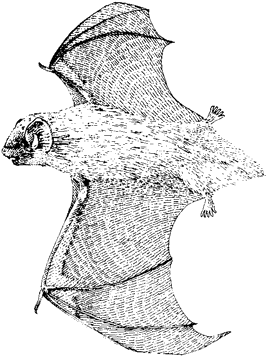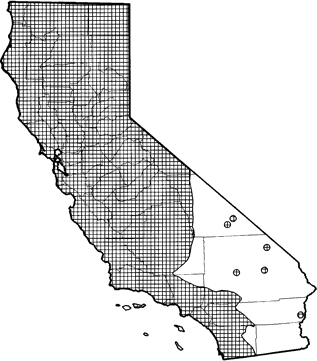
Hoary Bat
Distribution, Abundance, and Seasonality
The hoary bat is the most widespread North American bat. May be found at any location in California, although distribution patchy in southeastern deserts. This common, solitary species winters along the coast and in southern California, breeding inland and north of the winter range. During migration, may be found at locations far from the normal range, such as the Channel Islands (Brown 1980) and the Farallon Islands (Tenaza 1966). Habitats suitable for bearing young include all woodlands and forests with medium to large-size trees and dense foliage. Hoary bats have been recorded from sea level to 4125 m (13,200 ft). There is evidence that sexes are separate during the warm months, females being more abundant in the northeastern U.S., males in the west. Both sexes occur on the winter range. During migration in southern California, males are found in foothills, deserts and mountains; females in lowlands and coastal valleys (Vaughan and Krutzsch 1954).

Range Map
Specific Habitat Requirements
Feeding: Numerous studies have shown that the hoary bat feeds primarily on moths, although various flying insects are taken (Black 1974, Whitaker et al. 1977, 1981). Studies in Hawaii, where no other bat species occur, have revealed a more varied diet (Whitaker and Tomich 1983), suggesting that moth specialization in the continental U.S. may be a result of competition with other bat species. Foraging flight of the hoary bat is fast and straight.
Cover: Generally roosts in dense foliage of medium to large trees. Preferred sites are hidden from above, with few branches below, and have ground cover of low reflectivity. Females and young tend to roost at higher sites in trees.
Reproduction: Females bear young while roosting in trees, preferring sites as described under cover requirements. Females may leave the young in the roosting site while foraging.
Water: Requires water. This species has relatively poor urine-concentrating abilities (Geluso 1978).
Pattern: Prefers open habitats or habitat mosaics, with access to trees for cover and open areas or habitat edges for feeding.
Species Life History
Activity Patterns: Nocturnal. Hibernates. Emerges late in the evening. Peak activity varies with season and location, but usually is 3-5 hr after sunset. Individuals wintering in cold climates hibernate, but may be active on warm winter days. The hoary bat tolerates a wide range of air temperatures, and has been found foraging at temperatures of 0-22Á C (32-72Á F).
Seasonal Movements / Migration: Migrates between summer and winter ranges, probably over long distances. During spring and fall, large groups are encountered, occasionally in unusual locations. Females precede males in the northward spring migration, which occurs from February-May. Fall migration occurs from September-November.
Home Range: No data found.
Territory: Solitary.
Reproduction: Copulation occurs in autumn, in migration or on the wintering grounds. Mating is followed by delayed fertilization. The young are born from mid-May through early July. From 1-4 young may be born, but most litters have 2. The offspring are capable of flight after 33 days.
Niche: Forages with many other bat species. This species is a moth specialist (Black 1974). This specialization may be a result of competition, based on studies in Hawaii, where there are no other bat species (Whitaker and Tomich 1983). In some areas, abundance of hoary and red bats is inversely related (Kunz 1973). A few hoary bats have attacked pipistrelles (Shump and Shump 1982). There is a relatively high incidence of rabies in this species (Shump and Shump 1982). No important predators are known, but owls probably prey on hoary bats.
Sources & References
California Department of Fish and Game, 1999.
California's Wildlife, Sacramento, CA.
Written by: J. Harris, reviewed by: P. Brown, edited by: D. Alley, R. Duke
Barbour, R. W., and W. H. Davis. 1969. Bats of America. Univ. of Kentucky Press, Lexington. 286pp. Bell, G. P. 1980. Habitat use and response to patches of prey by desert insectivorous bats. Can. J. Zool. 58:1876-1883. Black, H. L. 1972. Differential exploitation of moths by the bats, Eptesicus fuscus and Lasiurus cinereus. J. Mammal. 53:598-601. Black, H. L. 1974. A north temperate bat community: structure and prey populations. J. Mammal. 55:138-157. Brown, P. E. 1980. Distribution of bats of the California Channel Islands. Pages 751-756 in D. M. Power, ed. The California Islands. Santa Barbara Mus. Nat. History. 787pp. Constantine, D. G. 1966. Ecological observations on lasiurine bats in Iowa. J. Mammal. 47:34-41. Dalquest, W. W. 1943. Seasonal distribution of the hoary bat along the Pacific Coast. Murrelet 24:21-24. Dalquest, W. W. 1953. Mammals of the Mexican State of San Luis Potosi. Louisiana State Univ. Press, Baton Rouge. 229pp. Farney, J., and E. D. Fleharty, 1969. Aspect ratio, loading, wing spans and membrane area of bats. J. Mammal. 50:362-367. Findley, J. S., and C. Jones. 1964. Seasonal distribution of the hoary bat. J. Mammal. 45:461-470. Geluso, K. N. 1978. Urine concentrating ability and renal structure of insectivorous bats. J. Mammal. 59:312-323. Kunz, T. H. 1973. Population studies of the cave bat (Myotis velifer): reproduction, growth and development. Occas. Pap. Univ. Kans. Mus. Nat. Hist. 15:1-43. Orr, R. T. 1950. Unusual behavior and occurrence of red bats in San Francisco. J. Mammal. 31:456-457. Orr, R. T. 1950. Notes on the seasonal occurrence of red bats in San Francisco. J. Mammal. 31:457-458. Provost, E. E., and C. M. Kirkpatrick. 1952. Observations on the hoary bat in Indiana and Illinois. J. Mammal. 33:110-113. Shump, K. A., Jr., and A. U. Shump. 1982. Lasiurus borealis. Mammal. Species No. 183. 6pp. Tenaza, R. T. 1966. Migration of hoary bats on South Farallon Island, California. J. Mammal. 47:533-535. Vaughan, T. A., and P. H. Krutzsch. 1954. Seasonal distribution of the hoary bat in southern California. J. Mammal. 35:431-432. Whitaker, J. O., Jr., and P. Q. Tomich. 1983. Food habits of the hoary bat, Lasiurus cinereus, from Hawaii. J. Mammal. 64:151-152. Whitaker, J. O., Jr., C. Maser, and L. E. Keller. 1977. Food habits of bats of western Oregon. Northwest Sci. 51:46-55. Whitaker, J. O., Jr., C. Maser, and S. P. Cross. 1981. Food habits of eastern Oregon bats, based on stomach and scat analyses. Northwest Sci. 55:281-292.
California Animal Facts | California's Wildlife